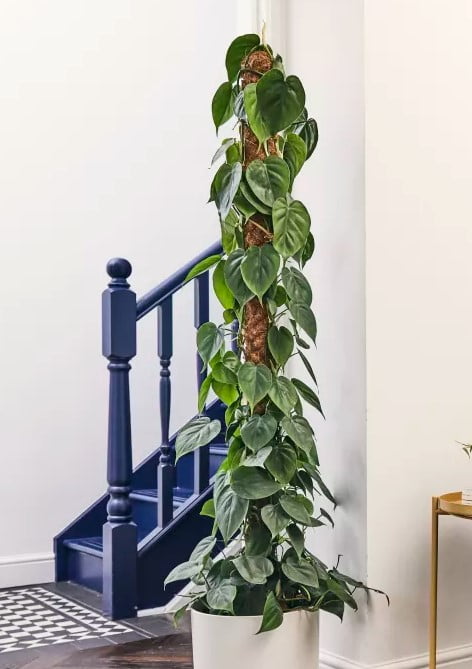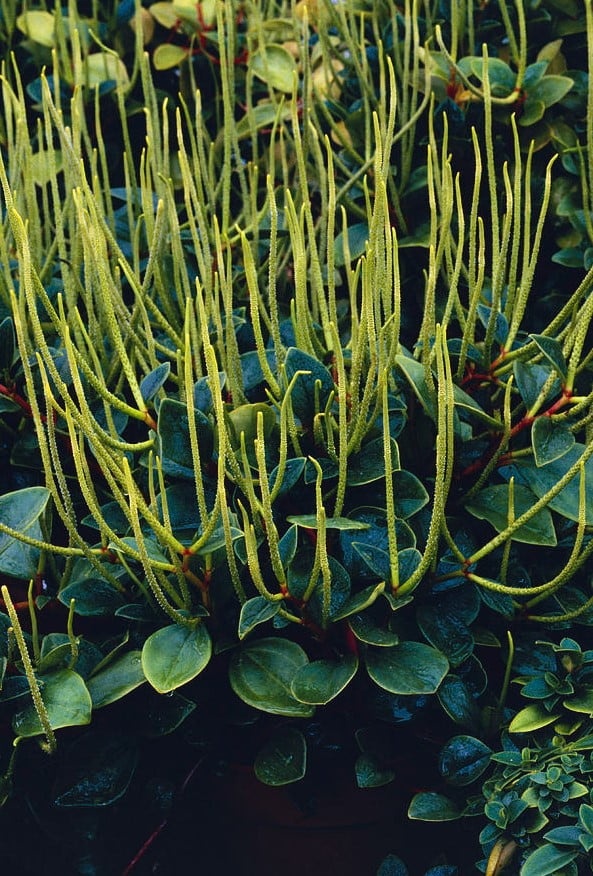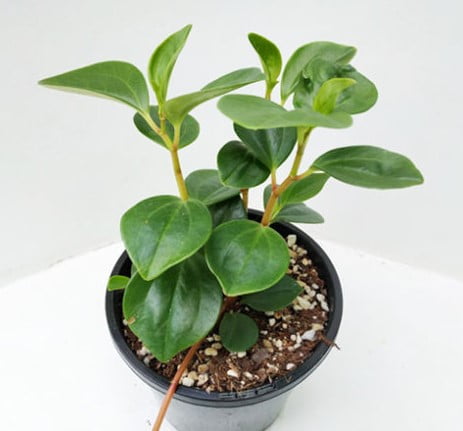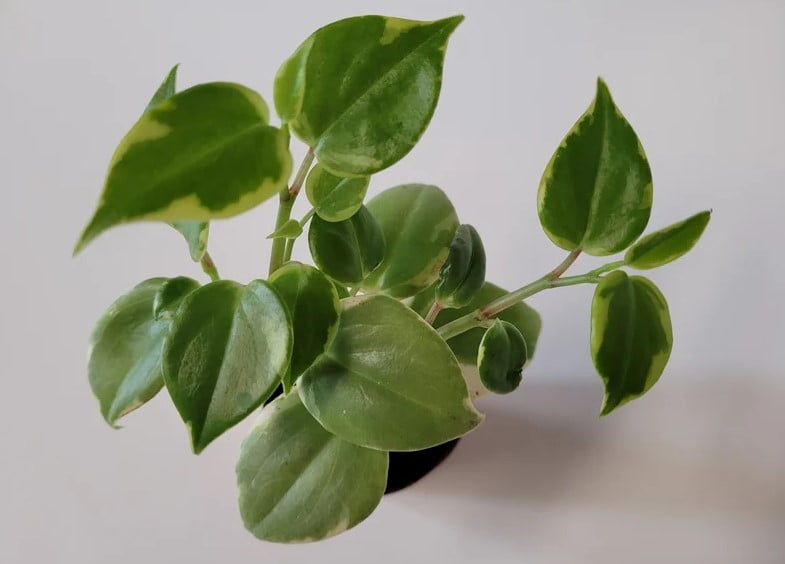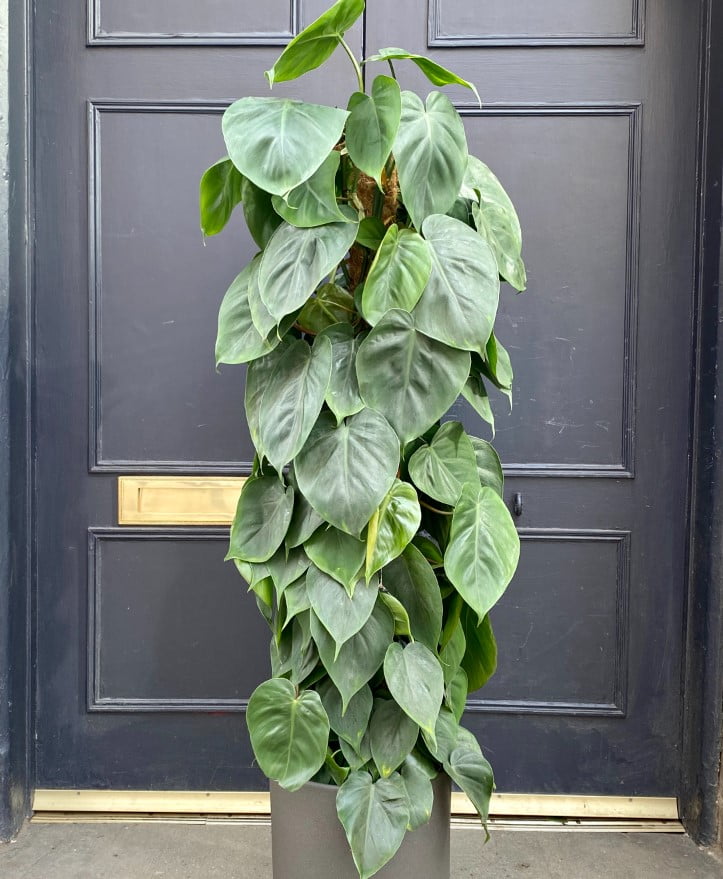False philodendron, also called Peperomia scandens, is a beloved houseplant with beautiful leaves.
It is a member of the Piperaceae family of plants, which includes pepper plants. This species is from the tropical regions of Central and South America. It grows as an epiphyte in rainforest canopies.
In the wild, P. scandens uses its vines to climb up tree trunks and branches. This plant is great for hanging baskets or as a trailing potted plant indoors. Its lush green heart-shaped leaves can reach 2–5 inches long on trailing stems, growing up to 5 feet long.
The leaves of P. scandens are somewhat fleshy, so the plant can handle dry periods. Its leaves and stems have the ability to store water. But this plant still needs the right amount of water, light, and soil conditions to grow indoors.
P. scandens is low-maintenance but requires bright indirect light and well-draining soil. This rainforest plant likes consistent moisture in the air, so humidity is important. This Peperomia plant grows well indoors and adds beauty to any plant collection.
Key Takeaways:
| Key Takeaways | Actionable Steps |
|---|---|
| Natural Habitat | Originates from tropical South America. |
| Light, Temperature, Humidity | Provide bright indirect light, 65-80°F, and maintain 50-60% humidity. |
| Soil and Watering | Use well-draining mix, allow partial drying between waterings to prevent root rot. |
| Fertilization | Monthly, use diluted balanced fertilizer in the growing season; stop in fall and winter. |
| Propagation | Easily propagate from stem or leaf cuttings; repot every 2-3 years in spring. |
| Pruning | Trim dead stems, control leggy growth by pinching back long vines. |
| Pest Management | Watch for pests like mealybugs and spider mites; treat promptly with insecticidal soap. |
| Aesthetic Appeal | Lush trailing foliage ideal for hanging baskets or climbing supports. |
This growing guide covers how to provide the ideal care for P. scandens. The information covers how to water and light the plant, as well as its soil and humidity needs. It also includes tips on fertilizing, propagating, and dealing with pests or diseases. If you follow these tips, your fake philodendron will thrive. It will make you happy with its hanging vines and green leaves.
Peperomia scandens is from the tropical regions of South America. It grows as an epiphyte in rainforest canopies. This gives us clues about its preferred growing conditions.
Growing Conditions
Temperature
P. scandens prefers temperatures between 65 and 75°F. It thrives in warm conditions of 60–80 °F because it is a tropical plant. Temperatures below 50°F can harm it. In its native habitat, temperatures typically remain warm year-round. To grow P. scandens indoors, shield it from drafts caused by windows or doors that lower temperatures suddenly. Maintain consistent warmth around the plant. In summer, temperatures above 80°F are tolerated if humidity is increased.
Light
Peperomia scandens does best in bright, indirect light. In its rainforest home, it gets sunlight that shines through the trees. Indoors, place P. scandens near an east or west-facing window where it will get bright light for part of the day without direct, hot afternoon sun. Some morning or late-day direct sun is tolerated. Insufficient light will cause weak, leggy growth. Give it 8–10 hours of bright light daily.
Soil
This tropical epiphyte requires a very well-draining potting mix. Use a light, airy soil with lots of perlite, orchid bark, or vermiculite added. A good mix contains equal parts peat moss, perlite, and bark, or vermiculite. The soil should retain some moisture but drain well to prevent root rot. Allow the soil to partially dry out between waterings.
Humidity
Peperomia scandens thrives in the humid conditions of its tropical rainforest home. Replicate this by providing consistent humidity around 50–60%. Use a humidifier, pebble tray, or frequent misting to prevent dry air. Leaves will curl or brown along the edges if the humidity drops too low.
By mimicking the warm, bright, humid conditions of its native habitat, you can keep your P. scandens happy and healthy indoors!
How to Grow Peperomia Scandens
Propagation
Peperomia scandens is one of the easiest houseplants to propagate. This allows you to multiply your plant to fill hanging baskets or share with friends. There are a few different propagation methods that work well:
Stem Cuttings
Take 3–4-inch cuttings from the tips of healthy stems. Remove the bottom leaves and place the cutting in water or moist potting mix. Roots will form in 4–8 weeks. Once rooted, plant in soil.
Leaf Cuttings
Choose a healthy leaf and cut the petiole. Place the leaf cut-side down in soil or water. New baby plants will emerge from the base of the leaf.
Division
Carefully divide the rootball when repotting mature plants. Gently tease the roots apart and repot sections in small pots. Keep the soil moist until it is established.
Potting and Repotting
Peperomia scandens likes loose, well-draining soil. Use a general houseplant potting mix amended with perlite or orchid bark. Terracotta pots provide great airflow. Repot when rootbound, moving up just one size. Divide congested plants.
Supporting Growth
As a vining epiphyte, P. scandens needs support to climb. Use moss poles, trellises, or fishing line to train stems. Allow trailing from hanging baskets. Outdoors, it can climb trees or posts. Rotate plants periodically for even growth.
With these easy methods, you can grow your Peperomia scandens collection effortlessly. Proper support will encourage beautiful trailing or climbing habits.
Common Issues and Pests/Diseases of False Philodendron (Peperomia scandens)
Overwatering
Overwatering is one of the most common issues for Peperomia scandens. These plants prefer soil that dries out slightly between waterings. Too much moisture causes root rot, which appears as black, mushy roots. Overwatered Peperomia scandens will wilt, turn yellow, and drop leaves.
Allow the top few inches of soil to dry before watering again. Improve drainage by adding perlite to the soil.
Underwatering
If Peperomia scandens receives too little water, the leaves will shrivel and get crispy edges. The stems become droopy when severely underwatered.
Water thoroughly when the top inch of soil is dry. Increase water slightly in summer when growth is active.
Low Humidity
Peperomia scandens thrives in 40–60% humidity. In dry air, the leaf edges turn brown and curl upward. Use a humidifier or pebble tray to increase moisture around the plant. Group plants together to boost local humidity. Mist the leaves daily for added moisture.
Insufficient Light
Without enough light, Peperomia scandens gets leggy with few leaves. Slow growth and pale color are also signs of insufficient light. Give the plant very bright indirect or dappled light. Some direct morning sun is tolerated. Move to a brighter location or use a grow light to supplement.
Nutrient Deficiencies
Lack of fertilizer causes yellowing leaves and stunted growth. Fertilize monthly in spring and summer with a balanced liquid fertilizer diluted to 1/4 strength. Stop fertilizing over winter. If using proper fertilizer, poor drainage, causing nutrient deficiencies, is more likely.
Pests
Spider mites, mealybugs, and fungus gnats commonly attack Peperomia scandens. Check new plants closely for pests before bringing them home. Isolate infested plants and use insecticidal soap or neem oil treatments. Remove severely infested plants to prevent spreading.
Diseases
Overwatering encourages fungal diseases like root rot, leaf spot, and botrytis blight. Improve air circulation and water use. Propagation issues like rotting cuttings can be prevented with sterile tools and fresh water. Repotting shock is avoided by gentle handling of roots and new, appropriate soil.
Prevention
Start with pest- and disease-free plants from reputable sources. Provide proper growing conditions and care. Monitor plants frequently and address any issues promptly. With good care, Peperomia scandens remains quite healthy and problem-free.
Summary of Key Growing Conditions
Peperomia scandens thrives when given the proper care to mimic its native tropical habitat. This rainforest epiphyte needs high humidity, warm temperatures of 65-80°F, and bright indirect light. A well-draining, airy potting mix is essential to prevent root rot. Water thoroughly when the top inch of soil is dry, allowing it to drain fully. Mist frequently and use pebble trays to provide humidity around 50–60%.
Care Tips
With the right conditions, Peperomia scandens is quite easy to grow. Propagate new plants from stem or leaf cuttings. Repot every 2-3 years in spring, trimming congested roots.
Monthly diluted fertilizer feeds it during the growing season. Prune leggy growth in the early spring. Inspect new plants for pests and treat any infestations promptly.
An Excellent Houseplant
Peperomia scandens is a great houseplant with long vines and heart-shaped green leaves. Its versatility suits many spaces, cascading from baskets or climbing up supports. This adaptable semi-succulent stores water in its thick leaves. Once acclimatized, it tolerates some droughts.
The vibrancy and unique form of Peperomia scandens’ foliage add life and greenery to indoor plant collections. When given proper care, this false philodendron remains a manageable size and thrives for years as a houseplant.

